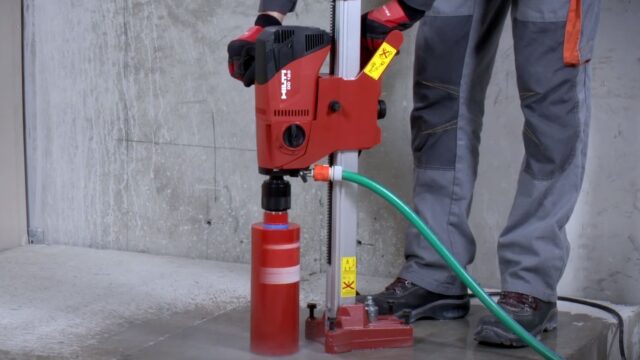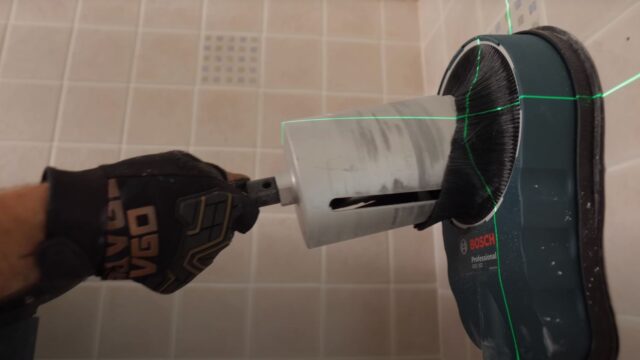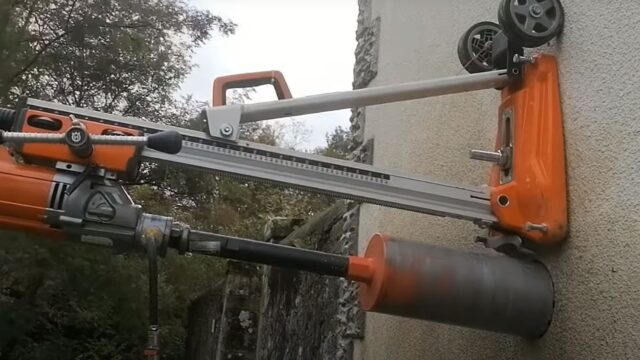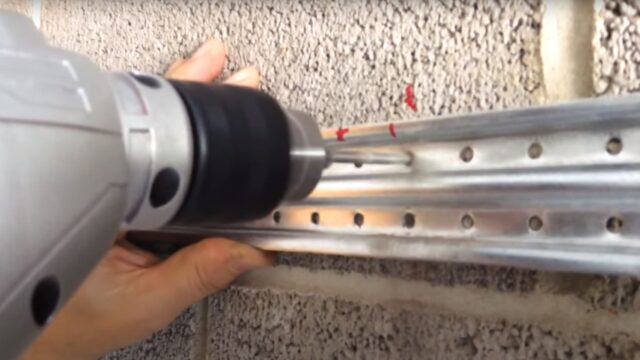Understanding Concrete Drilling
Concrete drilling, often referred to in the industry as concrete coring, is an essential process in many construction and renovation projects. It involves removing a cylinder of concrete from a larger structure. The cylinder, or ‘core’, can then be analysed for structural properties or, more commonly in home renovations, to create space for utilities like plumbing and electrical conduits.
Why Precautions Are Vital
- Safety First: The process is inherently dangerous if not done correctly. The high-speed drilling can cause fragments to fly, machinery can overheat, or the structural integrity of the surrounding area could be compromised.
- Quality Results: Without the proper precautions, you risk damaging not only the surrounding concrete but also the core itself. For someone in Auckland wanting concrete coring done for their home renovation, a damaged core could mean costly repairs or delays.
Key Precautions Before Drilling
- Survey the Area: Always check the spot you plan to drill for any signs of reinforcement, such as rebar or tension cables. You don’t want to hit these mid-drill as it can damage both your equipment and the structure.
- Wear Personal Protective Equipment (PPE): Essential PPE includes safety goggles to protect the eyes from flying debris, gloves to ensure a good grip on machinery, ear protection from the noise, and a dust mask.
- Ensure Adequate Ventilation: Concrete drilling can produce a significant amount of dust. Good ventilation ensures that this dust doesn’t pose a respiratory risk.
Auckland Council Bylaw Requirements
Residents of Auckland need to be especially mindful of regional bylaw requirements when undertaking any form of construction, including concrete drilling.
- Mount Eden and Ponsonby Specifics: For instance, in the suburbs of Mount Eden and Ponsonby, there are specific noise and vibration controls due to the presence of historical buildings. Drilling operations might be restricted to certain hours of the day, and you may be required to use specific machinery or techniques to reduce noise and vibration.
- Bylaw References: If you’re looking for a detailed guide, the regional council’s bylaw sections under the “Construction Noise and Vibration Management” outline these specifics. Always consult these bylaws before starting your project.
Techniques Employed by Auckland Concrete Cutters
Concrete drilling in Auckland is not a one-size-fits-all process. Due to the varied needs of different projects and the unique challenges presented by each site, Auckland concrete cutters employ a range of advanced techniques to ensure precision, safety, and efficiency.
Wet Drilling: A Dual-Purpose Approach
- Dust Management: One of the main reasons for using water during drilling is to manage and suppress the dust produced. This not only creates a cleaner work environment but also protects workers from inhaling fine concrete particles, which can be harmful.
- Cooling the Bit: The act of drilling produces significant frictional heat. Introducing water cools down the drill bit, reducing wear and tear and extending its operational life.
Diamond Core Drilling: Precision at its Best
- The Diamond Advantage: Diamonds are among the hardest known materials. Using a diamond drill bit allows for a cleaner, more precise cut, especially when dealing with reinforced concrete or particularly hard aggregates.
- Vibration Management: Diamond core drilling produces fewer vibrations compared to other methods. This is particularly important in areas where maintaining the structural integrity of surrounding materials is paramount.
Stitch Drilling: Creating Large Openings
When a large opening is required, or the shape is too intricate for a standard drill, stitch drilling comes into play. This method involves drilling a series of overlapping holes to create the desired shape or opening.
- Flexibility: This technique offers immense flexibility in terms of the size and shape of the cut.
- Precision: By controlling the overlap of each hole, precise and intricate shapes can be achieved with great accuracy.
Rotary Percussive Drilling: Speed and Efficiency
Incorporating both rotation and a hammering action, rotary percussive drills are perfect for quick drilling operations, especially in tougher concrete mixes.
- Rapid Penetration: The hammering action aids in faster penetration, especially when dealing with dense or reinforced concrete.
- Bit Longevity: The combination of rotation and percussion reduces the wear on the drill bit, ensuring longer operational life.
Depth Control and Laser Guiding: Ensuring Accuracy
With advancements in technology, many Auckland concrete cutters now employ laser-guided systems and depth control mechanisms.
- Laser Guiding: This ensures that the drilling is perfectly aligned, reducing chances of angled or skewed holes which can compromise the structural integrity or aesthetics of the project.
- Depth Control: By controlling the depth of the drill, cutters can ensure they don’t drill too deep or too shallow, especially critical when avoiding underlying utilities or reinforcements.
The range of techniques and technologies employed by Auckland concrete cutters underscores the complexity and precision involved in concrete drilling. By understanding and selecting the appropriate method, these professionals ensure that each project is executed with the highest standards of safety and accuracy.
Understanding the Science Behind the Drill
When dealing with a substance as robust and multifaceted as concrete, it’s imperative to grasp the underlying science to ensure a precise and safe drilling process.
Concrete’s Composition
At its core, concrete is a composite material, formed from a blend of cement, water, and aggregates. These aggregates can vary, ranging from sand and gravel to crushed stones. The cement and water create a paste that binds these aggregates together. Over time, a chemical reaction called hydration takes place, hardening this mix into the concrete we are familiar with.
Concrete’s Unique Properties
- Compression vs. Tension: Concrete exhibits incredible strength when compressed, making it an ideal material for structures that bear heavy loads. However, its tensile strength – its ability to resist being pulled apart – is its Achilles’ heel. This disparity in strengths is why reinforcements like rebar are often incorporated, compensating for its weaker tensile strength.
- Porosity: Despite appearing solid, concrete is surprisingly porous. Its porosity affects its strength and durability. The voids or pores in concrete can be a result of the water to cement ratio used in the mix. A higher ratio can lead to more voids, reducing its overall strength.
- Thermal Properties: Concrete has the ability to store heat, a property known as thermal mass. This is why in some climates, concrete structures can remain warmer in winters and cooler in summers.
Drilling Dynamics
When you introduce a drill to concrete, several interactions take place:
- Frictional Heat: As the drill bit rotates and penetrates the concrete, it generates heat due to friction. This is why cooling, often via water, is essential. Without cooling, the bit can overheat, causing wear or even damage to the concrete itself.
- Bit Wear: The hardness of concrete, especially when aggregates like quartz or certain types of rock are present, can wear down drill bits over time. Auckland concrete cutters often opt for diamond-tipped bits when working on harder concretes to prolong the bit’s life and ensure a smoother drilling process.
- Vibration and Structural Integrity: Drilling induces vibrations within the concrete. If not managed properly, these vibrations can lead to micro-cracks, which may compromise the structural integrity. Proper technique, the right equipment, and regular checks are vital to prevent this.
To be adept at concrete drilling, one needs not only the right tools but also an in-depth understanding of these scientific principles. This knowledge ensures the drill doesn’t just pierce the concrete but does so in the most efficient, safe, and effective way possible.
Post-drilling Considerations
Once the drilling is complete, it’s not just about packing up and leaving. Here are some steps that are essential:
- Inspect the Core: This not only gives insights into the quality of your drilling but also the structural properties of the concrete.
- Clean the Area: Concrete drilling can leave a mess. It’s not only courteous but also safer to clean up after your drilling, ensuring no debris or tools are left behind.
- Check the Structural Integrity: Especially if multiple cores are taken out close to each other, or if the drilling was near the edge of a structure, it’s important to ensure there’s no risk of collapse or structural damage.
In Conclusion
Concrete coring is more complex than just drilling a hole. It requires a thorough understanding of the material you’re working with, the tools you’re using, and the environment you’re in. By adhering to best practices and keeping the Auckland-specific considerations in mind, one can ensure a successful and safe drilling experience.
Key Takeaways
- Safety and Precision are Paramount: Drilling into concrete isn’t just about making a hole. It requires a meticulous approach to ensure the safety of both the workers and the structure. From wearing the right Personal Protective Equipment to choosing the right drilling technique, every step matters.
- Concrete’s Complex Nature: Understanding the composition and properties of concrete, from its tensile strengths to its porosity, is essential. This knowledge guides decisions on drilling techniques and tool selection to ensure the integrity of the structure remains uncompromised.
- Diverse Techniques for Different Needs: Auckland concrete cutters deploy a range of advanced techniques, from wet drilling and diamond core drilling to stitch drilling, depending on the project’s specific requirements. Each method offers unique advantages tailored to different challenges.
- Local Bylaws Influence Drilling Decisions: In Auckland, specific suburbs like Mount Eden and Ponsonby have regulations due to the presence of historical buildings. It’s essential to be aware of these bylaws, as they can impact drilling times, methods, and equipment choices.
- Advancements Enhance Outcomes: The introduction of technology, like laser-guiding and depth control mechanisms, has significantly improved the accuracy and efficiency of concrete drilling. These advancements ensure that modern concrete coring methods are more precise and reliable than ever before.
Frequently Asked Questions about Concrete Drilling in Auckland
1. Why is wet drilling commonly used in concrete drilling?
Wet drilling serves two primary purposes: it suppresses the dust generated during the drilling process, ensuring a cleaner work environment, and it cools down the drill bit, reducing wear and prolonging its lifespan.
2. What is the difference between concrete drilling and concrete coring?
While both involve making holes in concrete, concrete drilling usually refers to creating smaller holes for bolts, screws, or small conduits. Concrete coring, on the other hand, is the process of removing a cylinder of concrete, often for larger utilities, structural analysis, or creating larger openings.
3. I live in Mount Eden; are there specific drilling restrictions I should be aware of?
Yes, in suburbs like Mount Eden and Ponsonby, there are specific Auckland Council bylaws related to noise and vibration controls due to the presence of historical buildings. It’s essential to consult these regulations before initiating any drilling operations.
4. How do I know which drilling technique is best for my project?
The ideal drilling technique depends on multiple factors: the type of concrete, its location, the size of the hole, and the project’s specific requirements. Engaging with professional Auckland concrete cutters will help determine the most suitable method for your needs.
5. Is concrete drilling safe for the structure?
When done correctly, concrete drilling is safe and does not compromise the structural integrity. However, precautions, such as avoiding drilling too close to the edge or near other holes, are crucial. Regular structural checks after drilling ensure the building’s safety.
6. Can I drill into reinforced concrete?
Yes, but it requires more care and often specialised equipment. Hitting reinforcement like rebar can damage the drill bit and the concrete. Diamond core drilling is a preferred technique for reinforced concrete as it provides a precise and clean cut.
7. Why is concrete’s tensile strength an important consideration during drilling?
Concrete has high compressive strength but lower tensile strength. Drilling induces forces that can exploit this tensile weakness, potentially causing cracks or weakening the structure. Knowledge of this property ensures that drilling is done with care to maintain structural integrity.
8. What happens to the cylindrical piece of concrete removed during coring?
The removed piece, often referred to as the ‘core’, can be analysed to understand the concrete’s structural properties. In most home renovations, the core is discarded, but in larger projects or studies, it might be subjected to various tests.
9. How deep can you drill into concrete?
The depth largely depends on the equipment used and the project’s requirements. However, it’s crucial to know what lies beneath the drilling site, like utilities or reinforcements, to prevent damages.
10. Why is there a need for laser-guiding in concrete drilling?
Laser-guiding ensures that the drilling is perfectly aligned. It reduces the chances of angled or skewed holes, which can compromise the project’s structural integrity or aesthetics.
References
- Smith, J. (2018). Basics of Concrete: Composition & Properties. Auckland: Auckland Construction Publications.
- Thompson, K., & O’Reilly, P. (2019). Drilling Dynamics: A Comprehensive Guide. North Shore Builders Press.
- Martin, R. (2020). Auckland Concrete Cutting: Techniques and Best Practices. New Zealand: Kiwi Building Review.
- Auckland Council. (2022). Auckland Construction Bylaws and Guidelines. Retrieved from https://www.aucklandcouncil.govt.nz.
- Lewis, H. (2017). Concrete Porosity and Its Impact on Building Structures. Wellington: NZ Building Standards Journal.
- Patel, D. (2021). The Science Behind Drilling: A Deep Dive into Techniques and Technologies. Christchurch: Canterbury Construction Chronicles.
- New Zealand Construction Association. (2019). Safety Guidelines for Concrete Drilling and Coring. Wellington: NZCA Publications.
- Green, L., & McAllister, T. (2018). Diamond Core Drilling in New Zealand. Dunedin: Otago Construction Forum.
- Jenkins, B. (2020). Innovations in Drilling: Laser Guiding and Beyond. Hamilton: Waikato Builder’s Journal.
- Foster, G. (2019). Concrete and Its Many Faces: A Comprehensive Overview. Palmerston North: Massey Building Reviews.



